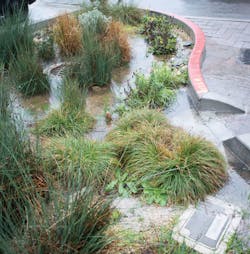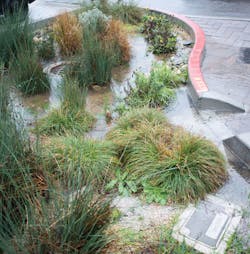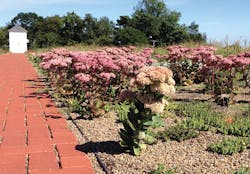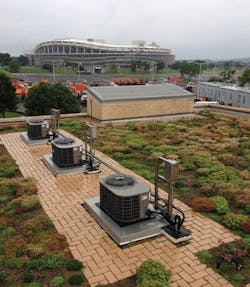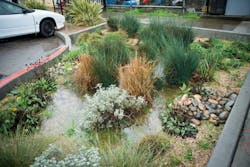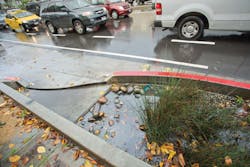Bold and the Beautiful: How Complementing Gray Infrastructure with Green Helps Ease Pressure on Stormwater Systems While Beautifying Dense Urban Environments
By Sarah Fister Gale
Rain gardens. Bioswales. Permeable pavement. These may not sound like the typical infrastructure projects for a major water utility, but in some leading cities, they are becoming a key component in the effort to better manage stormwater runoff. These projects are all elements of the green infrastructure movement, in which utilities build a series of small nature-driven initiatives that are designed to capture stormwater before it enters the "gray" wastewater treatment system.
"Green infrastructure refers to the biological process of using soil and plants to treat water naturally," said Gary Belen, senior director of the clean water supply program at American Rivers, a national non-profit conservation organization in Washington, D.C., dedicated to protecting and restoring America's rivers. And these systems provide many financial, environmental and regulatory benefits. These natural water management solutions capture the stormwater long enough to allow plants and soil to soak it up like a sponge, which helps these plants, naturally filters out non-point pollutants, and lightens the load on urban stormwater systems and overflow basins. This is especially important in crowded urban environments where the pervasiveness of impermeable roadways, buildings and other non-porous surfaces increases the volume of stormwater runoff, which can lead to overflows in combined sewer and stormwater systems.
Tom Barrett, president of Green Water Infrastructure Consulting in Indianapolis, Ind., noted that more than 179 municipalities in the U.S. have some level of combined storm and sewer system, and many of them are struggling to accommodate EPA requirements to eliminate these overflow episodes. "Green infrastructure can be a less expensive and more effective solution than a massive civil works project," he said. And they can be scaled up or down based on the changing needs of the community. This means that they can be adapted to accommodate growth in urban development or the increased frequency or severity of storm systems. "You can't do that with a 20-year gray infrastructure system," he added.
Green infrastructure also provides ancillary benefits, including more shade, reduction of heat islands, animal habitats, and overall beautification of the city. These societal benefits can have a big impact on public buy-in for infrastructure investment, said Rosey Jencks, head of the urban watershed management and stormwater planning program for San Francisco's Public Utilities Commission. "When cities invest in gray infrastructure, people can't see the benefit, but green infrastructure exists in the community space," she said.
However, it is important to note that green infrastructure is not a replacement for gray infrastructure. No one is suggesting that cities tear down water treatment facilities and replace them with porous forests and rain gardens, Belen said. "It isn't a juxtaposition between gray and green," he explained. "We find that they can both be more effective when used together."
Counting Every Drop
Green infrastructure is becoming a popular trend in the sustainable cities movement, with urban leaders rolling out various projects across their cities as a way to cost-effectively manage stormwater while benefitting from the public image that comes with going green.
Philadelphia was one of the early adopters in this movement, rolling out an $800-million green infrastructure plan in 2013 that includes dozens of rain gardens, infiltration beds and porous pavement alleys and driveways throughout the city. Though Philly is far from alone: In recent years, other major cities, including Chicago, San Francisco, New York, Denver, and Washington, D.C., have rolled out their own green infrastructure plans in the quest to solve combined sewer overflow issues without adding massive new treatment facilities.
The projects themselves are relatively simple. They often require simply reworking corner parks and boulevards into rain gardens and replacing blacktop roads and roofs with more absorbent alternatives.
But while these projects are small and easy in theory, they require a big culture change to even be considered by most water utilities. These projects don't fit the traditional wastewater treatment construction process, and there are no regulations, standards or building codes governing how or where these projects should be implemented, Barret said. Lack of knowledge about what they are and how they work -- among both water treatment engineers and the public at large -- can make it difficult to secure buy-in and financing even for pilot projects.
They also use land and resources in a totally different way, said Jencks. Project investments tend to be small and dispersed across the city as opposed to centered in a massive facility. "It's more akin to urban design than wastewater infrastructure," she said.
Despite these obstacles, forward-looking city leaders have been funneling more resources into green infrastructure projects to at least test their viability. San Francisco for example, earmarked $400 million as part of its multi-billion, 20-year Sewer System Improvement Program (SSIP) for eight green infrastructure pilot projects, including the addition of rain gardens and permeable paving along the city's famous ‘Wiggle' bike route.
To ensure that these projects deliver demonstrable impact, each project plan includes key performance indicators to measure how much stormwater they divert from the sewer system during any given storm, Jencks said.
Being able to measure the impact of these green projects is critical to helping public utilities and their funders embrace the concept of rain gardens and other green projects as a viable solution for stormwater management. While it may seem like measuring the impact of a rain garden or permeable alleyway would be next to impossible, it is in fact surprisingly easy, according to Jencks. "Water goes into the soil in a pretty predictable way," she said, noting that her team uses similar parameters to track water absorption as they would any other piece of infrastructure. "You size a rain garden the same way you size a pipe," she added. "It just requires a new way of thinking."
Jencks's team identified the areas of the city most sensitive to stormwater, then built flow monitors to study performance. Based on that data, which included average rainfall and flow rates, they were able to predict the amount of water that would be transferred into the environment and away from sewers. "The assumptions used in the model have been very accurate," she said. And in many cases, projects have produced even better than expected results.
Plant Gardens Not Tunnels
DC Water will rely on similar models to demonstrate the benefits of its recently launched green infrastructure plan. In May of this year, the utility announced its intention to abandon plans to build the Rock Creek underground tunnel as part of its Clean Rivers Project and will instead install a series of green infrastructure projects and targeted sewer separation to manage the volume of runoff produced by 1.2 inches of rain falling on 365 impervious acres of land that currently do not absorb stormwater. The green infrastructure piece of the project will include rain gardens, bioswales, porous pavement, and green roofs designed to capture and clean runoff. The utility also plans to shrink the tunnel project for the Potomac site near Georgetown, as well as use gravity, rather than an energy-intensive pumping station, to passively transfer the contents to the city's Blue Plains wastewater treatment plant.
George Hawkins, CEO and general manager of DC Water, has been pushing for green infrastructure since he took the job more than five years ago, but he struggled to get the projects approved because of existing consent decrees that put virtually all future investments into gray infrastructure. "It took years to make it happen, but we are pleased that it is moving forward now," he said.
Hawkins noted that recent advances in measuring the impact of green infrastructure will make it easier for him to demonstrate the benefits of the first round of projects and hopefully spur future investments. "Over time, the impact of these projects has become much easier to define," he said. "Now, we can measure how much water a bioswale can hold almost exactly as well as we can measure the capacity of a tunnel."
However, Hawkins conceded that the predicted impact will only be accurate over the long term if the green infrastructure is properly maintained, which could be tricky. Because these projects are small and spread across the city, maintenance can be difficult to deliver -- or verify. "Bioswales can fill up with silt and muck, and if you don't dig them out, it blocks infiltration of water," he said. That means stormwater will head right back into the sewer system. Maintenance gets even more complicated when these projects are built on private land or on the rooftops of public or commercial buildings, where building managers and land owners are charged with keeping them operational.
"Our job now is to capture the imagination of the city and to educate them on what green infrastructure is and why it's important," Hawkins said. His team plans to place signage in high-traffic areas and to offer training to private individuals who implement green infrastructure designs on their own property.
It will be a challenge, and Hawkins expects to face some pitfalls as they ramp up investments in these projects, but he is confident the addition of green infrastructure to his gray system will only deliver positive economic and social benefits. "I'd encourage any city facing a combined sewer overflow challenge to consider a hybrid green and gray approach," he said. "The two systems complement each other, and they should both be a natural part of how we handle this issue."
About the Author: Sarah Fister Gale is a freelance journalist based in Chicago, Ill. Over the last 15 years, she has researched and written dozens of articles on water management trends, wastewater treatment systems and the impact of water scarcity on businesses and municipalities around the world.
